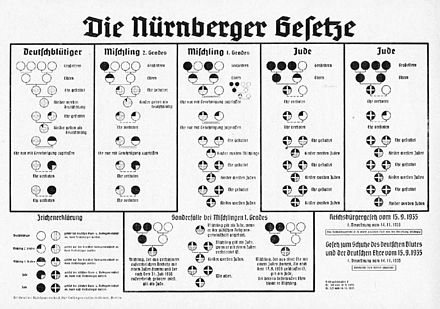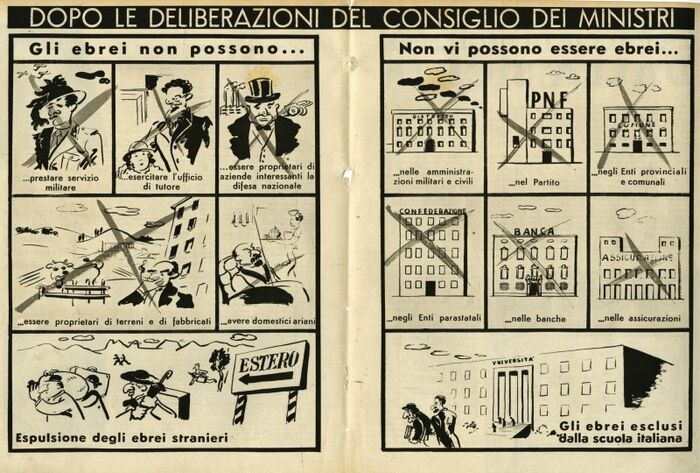Category:Racial Laws (subject)
Racial Laws (see Holocaust Children Studies)
Germany, 1935
Nazism believed that the Nordic Race/Culture constituted a superior branch of humanity, and viewed International Jewry as a parasitic and inferior race, determined to corrupt and exterminate both Nordic peoples and their culture through Rassenschande ("racial pollution") and cultural corruption.
As defined by the Nuremberg Laws in 1935, a Jew was a person – regardless of religious affiliation or self-identification – who had at least three grandparents who had been enrolled with a Jewish congregation. A person with two Jewish grandparents was also legally "Jewish" if that person met any of these conditions:
- Was enrolled as member of a Jewish congregation when the Nuremberg Laws were issued, or joined later.
- Was married to a Jew.
- Was the offspring from a marriage with a Jew, which was concluded after the ban on mixed marriages.
- Was the offspring of an extramarital affair with a Jew, born out of wedlock after 31 July 1936.
Italy, 1938
The Italian Racial Laws were announced by Mussolini on Sept 15, 1938 and approved in November 1938.
Pages in category "Racial Laws (subject)"
The following 11 pages are in this category, out of 11 total.
1
- Pietro Castelnuovo-Tedesco (M / Italy, 1925-1998), Holocaust survivor
- Ugo Yoram Treves (M / Italy, 1925-1948), Holocaust survivor
- Franco Di Consiglio (M / Italy, 1927-1944), Holocaust victim
- Amos Luzzatto (M / Italy, 1928-2020), Holocaust survivor
- Aldo Zecharia Treves (M / Italy, 1928-1948), Holocaust survivor
- Laura Massarani (F / Italy, 1929), Holocaust survivor
- Lorenzo Castelnuovo-Tedesco (M / Italy, 1930-2000), Holocaust survivor
- Paolo Calabresi (M / Italy, 1930-2003), Holocaust survivor
- Andrea Massarani (M / Italy, 1930), Holocaust survivor
- Guido Calabresi (M / Italy, 1932), Holocaust survivor
- Giulio Massarani (M / Italy, 1937), Holocaust survivor
Media in category "Racial Laws (subject)"
The following 3 files are in this category, out of 3 total.
- 2018 Suber (doc).jpg 1,000 × 1,429; 70 KB
- 2018 Treves.jpg 300 × 429; 31 KB
- 2022 Pavan.jpg 194 × 266; 9 KB




